With Fantastic Four. Vol. 1. 1961–1963, Taschen celebrates another idea of Marvel’s mastermind Stan Lee. Following the most welcome publication of recent volumes of the Taschen Marvel Comic Library, the superhero family of four is introduced here in a short text by former NASA astronaut Mike Massimino.
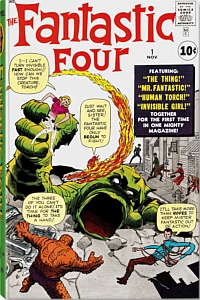 Followed by a long essay from acclaimed Marvel writer Mark Waid that gives insights about this very successful story and legendary “tag-team” conceived by Lee. As usual, rare photographs, sketches, alternate covers and panels, split pages and a mass of other goodies are included.
Followed by a long essay from acclaimed Marvel writer Mark Waid that gives insights about this very successful story and legendary “tag-team” conceived by Lee. As usual, rare photographs, sketches, alternate covers and panels, split pages and a mass of other goodies are included.
Maybe the most important difference of the team of four to other Marvel superheroes was their interest in the sciences, mostly space flight. The Fantastic Four discovered their superpowers after an accident on a space mission, and in a way they all were reborn in space. (Although, for example, the Hulk, Iron Man and Spiderman also were created during scholarly tragedies or unplanned experiments.)
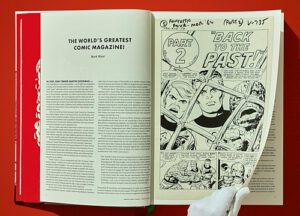 A strong desire for space exploration, engineering and astronomy, a typical contemporary interest in the early 1960s in the US, placed the Four on a rocket. Which is related to the start of the series during the days of the Space Race between the USA and the Soviet Union.
A strong desire for space exploration, engineering and astronomy, a typical contemporary interest in the early 1960s in the US, placed the Four on a rocket. Which is related to the start of the series during the days of the Space Race between the USA and the Soviet Union.
Realized by legendary comic artists Jack Kirby and Stan Lee, Mr. Fantastic, Human Torch, The Thing and Invisible Girl first were introduced in November 1961. Simultaneously, they heralded the birth of a publishing company, namely Marvel Comics, formerly Atlas Publishing. This new publisher would also go other ways, as “Marvel heroes were constantly dropping into one another’s series to guest-star, which ended up cross-promoting the entire line.”
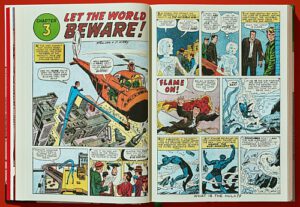 The special status of the Fantastic Four was further highlighted by their accessibility to the public, as they lived and worked in a huge building in New York City, with visitors and fans stopping by often. There was even a detailed floor plan of their headquarters in a skyscraper, the Baxter Building.
The special status of the Fantastic Four was further highlighted by their accessibility to the public, as they lived and worked in a huge building in New York City, with visitors and fans stopping by often. There was even a detailed floor plan of their headquarters in a skyscraper, the Baxter Building.
Furthermore, their identities were not really a secret. Neither did they wear capes, masks nor helmets; instead, they came in uniforms. Considering the fact that the Four were originally invented to encounter competitor’s DC Comics Justice League of America at the newsstand, they were a very different breed. (Even if we reckon that the Human Torch, in fact, was recycled from an earlier idea in an Atlas comic book, as was another character, Namor, the Sub-Mariner, who reappeared in issue 4.)
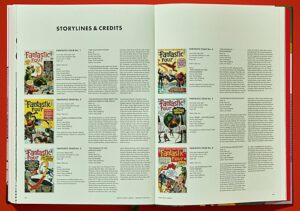 One of Marvel’s strategies, as the future would tell, was to make superheroes easily accessible to the readership, make identification with them simple, their (everyday) experiences relatable. The Human Torch and Invisible Girl were siblings, also a rare superhero status, but a very realistic setting for the audiences.
One of Marvel’s strategies, as the future would tell, was to make superheroes easily accessible to the readership, make identification with them simple, their (everyday) experiences relatable. The Human Torch and Invisible Girl were siblings, also a rare superhero status, but a very realistic setting for the audiences.
Besides, the team would function as a family, if one that fought intruders from outer space. And there they were: the four, too, for example “… had money problems. And, most important, they had human emotions. They felt guilt; they wallowed in envy; they knew fear; they acted out in anger. They had genuine interpersonal relationships, and their world initially responded to them not with applause but with terror and trepidation.” As in the Marvel universe, (wrong or bad) actions had real consequences, that would still be around several issues later.
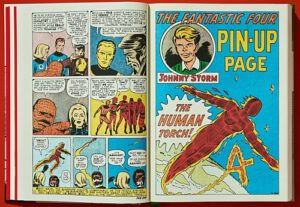 With the launch of The Fantastic Four No. 1, the team of Stan Lee as editor and Jack Kirby as the visual storyteller successfully used what was to become the “Marvel Method,” giving the illustrator a previously unknown amount of artistic freedom. This way, Kirby set the story and made decisions concerning panel size, colors and details, following the rough outline writer Lee suggested. Later, Lee would add dialogue and captions. (To be more exact, extra hands were employed producing the series; that cast included inker George Klein, staffer Sol Brodsky, letterer Artie Simek, and colorist Stan Goldberg.)
With the launch of The Fantastic Four No. 1, the team of Stan Lee as editor and Jack Kirby as the visual storyteller successfully used what was to become the “Marvel Method,” giving the illustrator a previously unknown amount of artistic freedom. This way, Kirby set the story and made decisions concerning panel size, colors and details, following the rough outline writer Lee suggested. Later, Lee would add dialogue and captions. (To be more exact, extra hands were employed producing the series; that cast included inker George Klein, staffer Sol Brodsky, letterer Artie Simek, and colorist Stan Goldberg.)
In the magnificent reprint of the first 20 issues of the series here – again in top quality provided by Certified Guaranty Company – we can observe the development of the Fantastic Four with the colors and layout of the vintage editions. Only the musty smell of old paper that usually accompanies vintage editions of the Silver Age is absent.
They come with every feature of the originals, including the letters to the editor, printed on the “Fantastic 4 Fan Page.” Get ready to encounter the Skrull, Doctor Victor von Doom, Reed Richards, The Fantastic Four, Prince Namor, Kurrgo, Master of Planet X, The Puppet Master, The Red Ghost and his Super-Apes, The Watcher, The Puppet Master, The Mad Thinker, Awesome Android, Ant-Man, Rama Tut, Impossible Man, and several other Marvel characters who drop by.
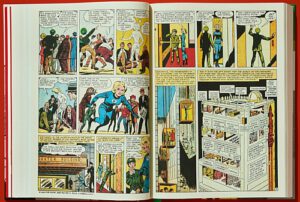 Just like the previous XXL Marvel editions, this super-book developed into 700 heavy pages, that explains the 10.48 lbs of weight and dimensions of 11 x 15.6 in. for the Famous First edition. The 5,000 copies are numbered on an extra page of the volume. As usual, with this special Taschen comic book treat, there is another, even more glamorous edition, the Collector’s Edition that comes in 1,000 numbered copies. This treasure features an aluminum print cover and a leatherette-bound spine, with foil embossing, and is housed in a slipcase. All of those extras add up to 11 lbs.
Just like the previous XXL Marvel editions, this super-book developed into 700 heavy pages, that explains the 10.48 lbs of weight and dimensions of 11 x 15.6 in. for the Famous First edition. The 5,000 copies are numbered on an extra page of the volume. As usual, with this special Taschen comic book treat, there is another, even more glamorous edition, the Collector’s Edition that comes in 1,000 numbered copies. This treasure features an aluminum print cover and a leatherette-bound spine, with foil embossing, and is housed in a slipcase. All of those extras add up to 11 lbs.
Make your choice, this is another must-have for comic book fans.
Review by Dr. A. Ebert © 2022
Mark Waid, Mike Massimino, Stan Lee and Jack Kirby. Marvel Comics Library. Fantastic Four. Vol. 1. 1961–1963. Taschen, 700 p. ISBN 978-3-8365-8231-5 (Famous First Edition)
Mark Waid, Mike Massimino, Stan Lee and Jack Kirby. Marvel Comics Library. Fantastic Four. Vol. 1. 1961–1963. Taschen, 700 p. ISBN 978-3-8365-9219-2 (Collector’s Edition)
